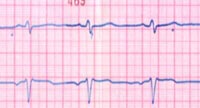Tackling volatile substance abuse in Scotland
a training course for the social care workforce
Course content: Risks
Health risks
Death


Anyone who experiments with volatile substances is placing him or herself at risk of sudden death. Many VSA deaths are sudden and unpredictable. Amongst the mechanisms of death are:
- Direct toxic effects. This category of deaths includes those resulting from abnormal heart rhythm (cardiac arrhythmia — see above). The heart becomes sensitive to adrenalin.
An arrhythmia occurring on the basis of volatile substance abuse is often unresponsive to cardiac massage and normal resuscitation.1 EURAD (Europe Against Drugs) have suggested that death can occur up to 24 hours later, should the young person then engage in vigorous exercise. There is a common misconception that death results as a result of freezing of the throat and the vagal nerve. Toxicologists believe that this is not a likely mechanism of death.A person who has recently used volatile substances is at particular risk.
- Inhalation and choking on vomit. Asphyxia (suffocation) through the use of plastic bags placed over the face.
- Accidents while disorientated. This may include trauma from falls, vehicle accidents, drowning. A number of deaths and serious injuries have been caused by fire or explosion when a vapour ignites.
Intoxication
The Advisory Council on the Misuse of Drugs (ACMD)2 states:
The common immediate effects of sniffing solvents are euphoria, confusion, unsteadiness and interference with coordination. Coughing, sneezing, salivation, flushing and a tendency to vomit are frequently reported. With more intense exposure intoxication becomes more marked, objects in the environment can look strange or out of perspective, and delusions and hallucinations can occur. Intoxication can progress to coma and death.
Accidents
Young people often use solvents in places away from normal adult access. This may include places that are inherently dangerous such as derelict buildings, railway sidings etc. so there is a significant risk of accidental trauma.
Tolerance and dependence
A tolerance to substances may develop, but it is rare to have a psychological dependence or craving for solvents, and physical withdrawal symptoms have been found in only a few isolated cases.
Perhaps more importantly a few people have a strong desire to continue using volatile substances over which they have little control. This is clinical dependence. Their lives may be chaotic and their behaviour self-destructive. The constant factor is the product of abuse and people often feel a strong affinity to the product.
Combined use with other substances
Ritalin
There were 254,000 prescriptions for Ritalin in the UK during 2002. The Ohio Early Alert highlighted a theoretical concern about a fatal interaction. This is a result of Ritalin having adrenalin-like effects which could enhance the possibility of sudden sniffing death in the individual inhaling volatile substances.3
There is little published information, however it is likely that combined use will make the effects of each substance more unpredictable and the risks greatly increased.
Chronic physical effects
The Advisory Council on the Misuse of Drugs (ACMD) conclude that there is some evidence that repeated or prolonged exposure to solvents may result in chronic damage to brain, optic nerve, inner ear, muscles, peripheral nerves, liver, kidneys, lung and bone marrow. Some damage may be reversible, but the cumulative effect of chronic use may result in irreversible damage. There are many case reports of the effects of long-term exposure to toluene (the main solvent in adhesives). There is very little information about long-term effects of butane.
VSA in pregnancy
Fatty tissues absorb volatile substances and there is a possible danger to the foetus if the mother misuses solvents.
Other medical effects
Depression or aggressiveness are frequently cited as linked to excessive use.
Social risks
Acceptance
It is unlikely that the use of volatile substances will meet with adults' acceptance. A lack of information may result in exaggerated fears and can result in an excessive response. This is obviously a potential cause of relationship difficulty.
VSA can have a low tolerance with young people. A study by McKeganey et al4 found from interviews with young people that experimentation with butane gas was seen as a normal part of growing up, but chronic use of glue was seen in very negative terms.
- Department of Forensic Medicine, University of Dundee, lecture notes. ↩
- The Advisory Council on the Misuse of Drugs (1995) Volatile Substance Abuse, HMSO. ↩
- Ohio Early Alert (2005) Potential interaction between Ritalin and inhalants. ↩
- McKeganey, N. (1998) Volatile Substance Abuse amongst Schoolchildren in Urban and Rural Parts of Scotland. ↩